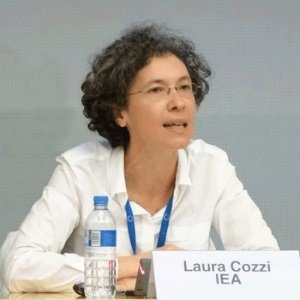International Energy Agency (IEA) - Experts & Thought Leaders
Latest International Energy Agency (IEA) news & announcements
Ukraine officially joined the International Energy Agency as an Association country today, with the signing of a joint declaration by Ukraine’s Minister of Energy German Galushchenko and IEA Executive Director Fatih Birol. The signing of the Joint Association Declaration at a ceremony in Warsaw, Poland, opens a new chapter in the long-standing partnership between the IEA and Ukraine to deepen and expand their work on the country’s energy security, clean energy transition and reconstruction efforts. The signing took place in the presence of Polish Climate and Environment Minister Anna Moskwa. Energy security role The IEA Governing Board agreed on June 16 to welcome Ukraine as the IEA’s 11th Association country, reflecting the Agency’s full support for Ukraine in the face of Russia’s aggression. The IEA Governing Board agreed on June 16 to welcome Ukraine as the IEA’s 11th Association country The Governing Board’s decision highlighted Ukraine’s important energy security role and IEA support for its reconstruction efforts. “The IEA has been working with Ukraine for almost two decades, and in these particularly challenging times following Russia’s unprovoked invasion, we are further strengthening the relationship to support Ukraine’s significant reconstruction needs and help it build a new energy future,” said Dr Birol. Strengthening energy security “Ukraine has an important energy security role in Europe and beyond – and it has set ambitious goals to increase energy trade with Europe and transition to cleaner energy. I’m delighted to be signing the Joint Declaration with Minister Galushchenko to expand our cooperation for achieving these goals.” "Solidarity is becoming even more important in these times of crisis. Only by being united, are we all able to implement the International Energy Agency’s mission to shape a secure and sustainable energy future,” said Minister Galushchenko. “As a part of Europe and as a candidate for EU membership, Ukraine is ready to take an active role in strengthening energy security in the region.” Energy demand restraint The IEA also recently completed a roadmap looking at how Ukraine can harness energy demand restraint The Joint Declaration states that Ukraine and the IEA intend to work together to develop policy and build capacity in a wide range of energyrelated fields, including market analysis, energy system reconstruction, energy security, efficiency, accelerated energy transitions, hydrogen and biomethane, and energy data and statistics. The specific initiatives are to be agreed upon in two-year joint work programs. The IEA has a long history of cooperation with Ukraine. Since 2007, the Agency has conducted four in-depth policy reviews and organized policy events and energy data capacity building in Kyiv and Odesa. The Agency has worked closely with Ukraine through the European Commission’s EU4Energy program. The IEA also recently completed a roadmap looking at how Ukraine can harness energy demand restraint, a topic that had been a priority for the government. Holding bilateral meetings The IEA’s Association framework allows the IEA to work closely and deepen cooperation with its partner countries, sharing analysis, data and best practices. Ukraine is the IEA’s 11th Association country. The framework was established in 2015 and the other Association countries are Argentina, Brazil, China, Egypt, India, Indonesia, Morocco, Singapore, South Africa and Thailand. IEA family members now represent some 75% of global energy demand. During his time in Warsaw today, Dr. Birol is holding bilateral meetings with Prime Minister Mateusz Morawiecki of Poland, Minister Galushchenko and Minister Moskwa. Later in the day, Dr Birol, Minister Galushchenko, Minister Moskwa and US Deputy Energy Secretary David Turk will take part in a livestreamed panel discussion on energy security.
With businesses around the world facing unprecedented pressure from the cost of energy and the urgency of climate change, a new report from the Energy Efficiency Movement shows that improving industrial energy efficiency is the fastest and most effective way for a business to cut energy costs and greenhouse gas (GHG) emissions. The Energy Efficiency Movement is a global forum of around 200 organizations sharing ideas, best practices and commitments to create a more energy-efficient world. ‘Industrial energy efficiency playbook’ The ‘Industrial energy efficiency playbook’ includes 10 actions that a business can take The ‘Industrial energy efficiency playbook’ includes 10 actions that a business can take to improve its energy efficiency, reduce energy costs and lower emissions right now. It focuses on mature, widely available technology solutions that will deliver rapid results and ROI – and are capable of being deployed at scale. “Energy efficiency is a win-win for companies and the climate,” said Kevin Lane, Senior Program Manager, Energy Efficiency, with the International Energy Agency (IEA), adding “While industry needs to address climate change on all fronts – such as increasing use of renewable energy, investing in low-carbon processes and developing circular business models – energy efficiency stands out as the business-focused opportunity with the best near-term prospects for emission reductions.” Industry - world’s largest consumer of electricity, natural gas Kevin Lane continues, “The 10 actions contained in this report are known, cost-effective resources, and can be employed at scale rapidly to help companies convert climate ambition into action.” Industry is the world’s largest consumer of electricity, natural gas and coal, according to the IEA, accounting for 42 percent of total electricity demand, equal to more than 34 exajoules of energy. The iron, steel, chemical and petrochemical industries are the largest consumers of energy among the world’s top-five energy-consuming countries – China, United States, India, Russia and Japan. Energy consumption carries high costs This energy consumption carries high costs in the current inflationary environment. It was also responsible for nine gigatons of CO2, equal to 45 percent of total direct emissions from end-use sectors in 2021, according to the IEA. Organizations interviewed for the report include ABB, Alfa Laval, DHL Group, the IEA, Microsoft and ETH Zürich, the Swiss Federal Institute of Technology. The contributors’ recommendations range from carrying out energy audits to right-sizing industrial machines that are often too big for the job at hand, which wastes energy. Moving data from on-site servers and into the Cloud Further actions involve installing sensors and real-time digital energy monitoring Moving data from on-site servers and into the Cloud could help save around 90 percent of the energy consumed by IT systems. Speeding up the transition from fossil fuels, by electrifying industrial fleets, switching gas boilers to heat pumps or using well-maintained heat exchangers will also offer efficiencies. Further actions involve installing sensors and real-time digital energy monitoring to reveal the presence of so-called ‘ghost assets’ that use power when on stand-by, unlike a digital twin that can simulate efficiency actions without interrupting production. Using smart building solutions to control power systems, lighting, blinds and heating, ventilation and air conditioning (HVAC) will also save energy in industrial facilities. Installing variable speed drives to enhance energy efficiency Other recommendations include installing variable speed drives that can improve the energy efficiency of a motor-driven system by up to 30 percent, yielding immediate cost and emissions benefits. If the more than 300 million industrial electric motor-driven systems currently in operation were replaced with optimized, high-efficiency motors, global electricity consumption could be reduced by up to 10 percent. Energy efficiency solutions to help mitigate climate change “There are energy efficiency solutions available that can help industry mitigate climate change and drive down energy costs, without compromising performance and productivity,” said Tarak Mehta, President, Motion business area at ABB. With recent technology advances in energy efficiency, the improvement potential in industry is significant" Tarak Mehta adds, “With recent technology advances in energy efficiency, the improvement potential in industry is significant and readily available. So, rather than turning the lights off and halting production to save money, this important new report explains practical steps executives can take to reduce energy use and their bills while maintaining current operations.” Business leaders and experts wanting to learn more about reducing their energy costs and carbon emissions are invited to join a special panel event that dives deep on the opportunities presented in the report and how to capitalize on them. The event will take place at 4 pm Central European Time / 10 am Eastern Time on Tuesday, December 13, 2022 and will be available afterward as video on demand. ABB ABB is a globally renowned technology company in electrification and automation, enabling a more sustainable and resource-efficient future. The company’s solutions connect engineering know-how and software to optimize how things are manufactured, moved, powered and operated. Building on more than 130 years of excellence, ABB’s approximately 105,000 employees are committed to driving innovations that accelerate industrial transformation. Energy Efficiency Movement The Energy Efficiency Movement is an initiative that brings together like-minded stakeholders to innovate and act for a more energy-efficient world. The Energy Efficiency Movement was launched by ABB in 2021 and it has received a positive reaction from throughout industry, with around 200 companies joining as of November 2022.
Siemens agreed to supply Electromin, the e-Mobility unit of Saudi Arabia’s lubricants and automotive services company Petromin, with electric vehicle (EV) chargers for its planned development of a Kingdom- and region-wide charging network. The agreement will ensure supplies of Siemens’ most advanced EV infrastructure technology for Electromin’s network, including the ultra-fast Sicharge D chargers that use direct current and the smart VersiCharge AC wall or pole-mounted units that run on alternating current. Locate public chargers Electromin is also developing a consumer app that will allow users to locate public chargers, plan their route, and book and pay for sessions. Electromin’s eMaaS solutions are contributing to the development of the Saudi EV ecosystem" “Electromin’s eMaaS solutions are contributing to the development of the Saudi EV ecosystem, and this partnership with Siemens will allow us to provide the charging infrastructure and technology necessary to boost the adoption of EVs in the Kingdom,” said Kalyana Sivagnanam, GCEO of Petromin Corporation and CEO Electromin. “The rollout of EV charging points across Saudi Arabia is our first phase of a significant national strategy that extends to 2030 and beyond.” Zero carbon emissions “We look forward to working with Electromin on this important project that demonstrates our commitment to supporting sustainability programs in Saudi Arabia,” said Karim Mousa, Senior Vice President of eMobility for Siemens in the Middle East. “Electric vehicles are the key technology to decarbonize road transport, and Siemens is proud to provide the infrastructure that accelerates the growth of EVs and contributes to the Saudi Green Initiative.” Saudi Arabia, the world’s biggest oil exporter, has committed to achieving net zero carbon emissions by 2060. The government wants three of every 10 vehicles in the Saudi capital Riyadh to be EVs by 2030. Globally, passenger electric cars are surging in popularity, and the Paris-based International Energy Agency estimates that 13% of new cars sold in 2022 will be electric.






















